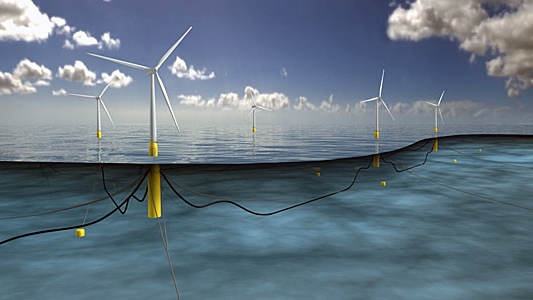Scotland has pioneered a new renewable energy technology: the world’s first commercial floating wind farm, which began delivering electricity to around 20,000 UK homes in October.
The 30 MW Hywind Scotland project is installed 25 km off the coast of Peterhead, Aberdeenshire, and is a joint project from companies Statoil and Masdar. Irene Rummelhoff, executive vice president of Statoil’s New Energy Solution business told The Engineer that the technology used for Hywind will open up previously inaccessible areas for an offshore wind farm, as it can be used in ocean depths up to 800 m.
Hywind Scotland substructure. (Photo: Olaf Nagelhus/Statoil)A traditional fixed foundation wind farm is limited to depths of less than 40 m, and can be installed no more than 30 km offshore. Costly vessels are also required to assemble and install fixed foundation turbines, and hard soil on the seabed can be a challenge.
In contrast, the Hywind turbines do not have conventional fixed foundations, but float on a cylindrical base tethered to the ocean floor. Each turbine weighs 10,000 metric tonnes and is 175 m in height. The angle of the blades adjusts dynamically with wind, waves and sea currents to keep the floating turbines in an upright position. Ballast is also used to ensure stability.
Hywind consists of six 5 MW floating wind turbines, with a total cost of £190 million (about AUD$325 million). The companies will also provide 1 MWh of lithium battery storage to optimise output and mitigate the intermittent energy supply. Funding for the project has been sourced from the UK government’s renewable energy plan.
Wind power is well-established in Scotland. In June, the nation’s existing wind farms produced a record amount of energy – enough to power every household in the country. This newest addition will help the country reach its goal of running completely on renewable energy by 2020, according to officials.
Photo: Statoil.CEO of the Carbon Trust Tom Delay stated that it was crucial that innovation continue to drive down costs, and policy be put in place to increase investment in offshore wind.
Floating wind turbines cannot currently compete commercially with fixed foundation offshore turbines, which have seen a 30 per cent cost reduction since 2012. However, The Engineer reported in July that Statoil believes that as floating wind farms are built at scale, they will soon be able to compete with fixed foundation offshore turbines without subsidies.


